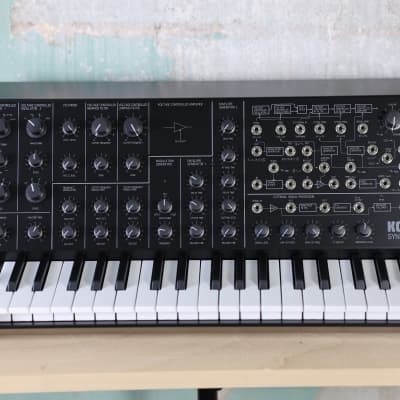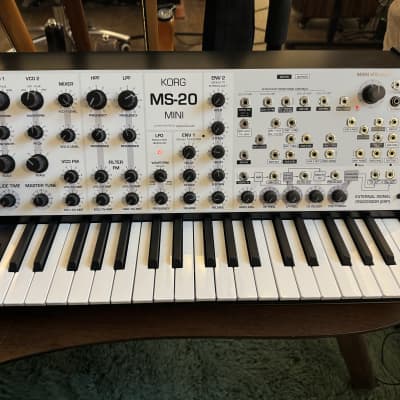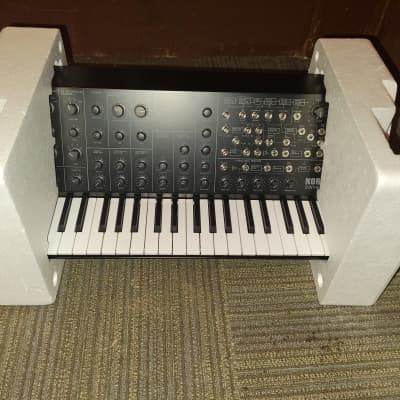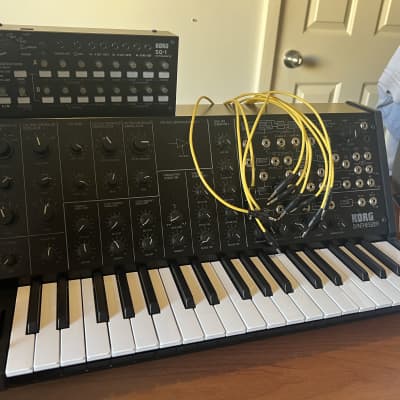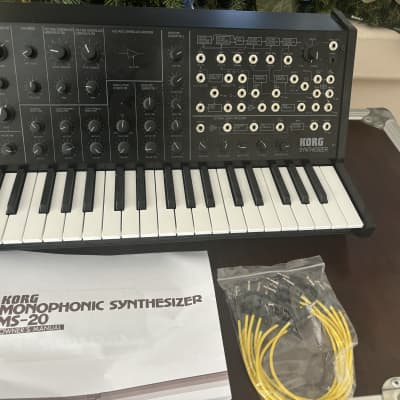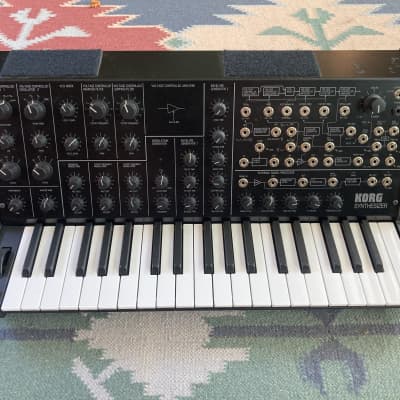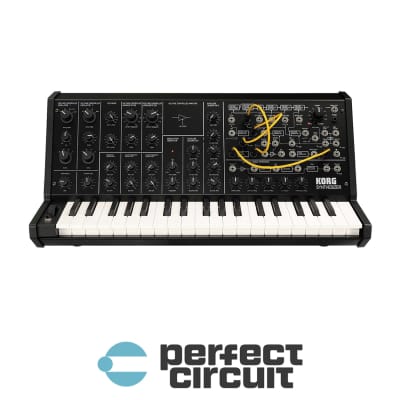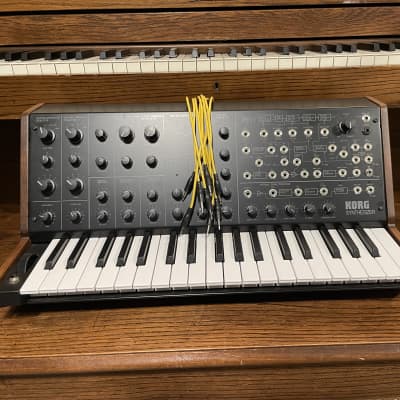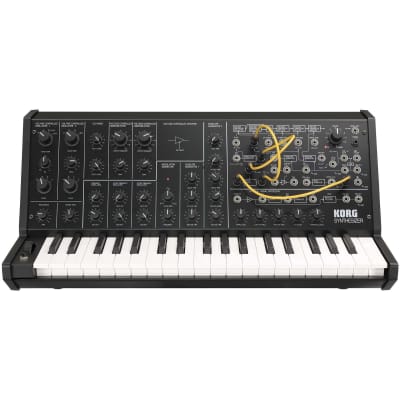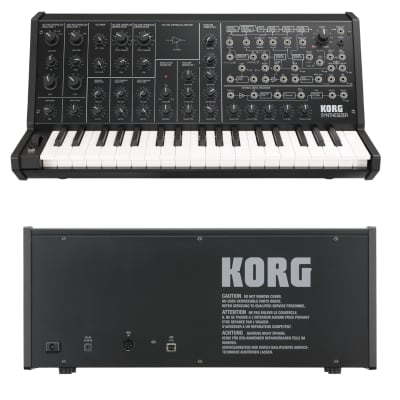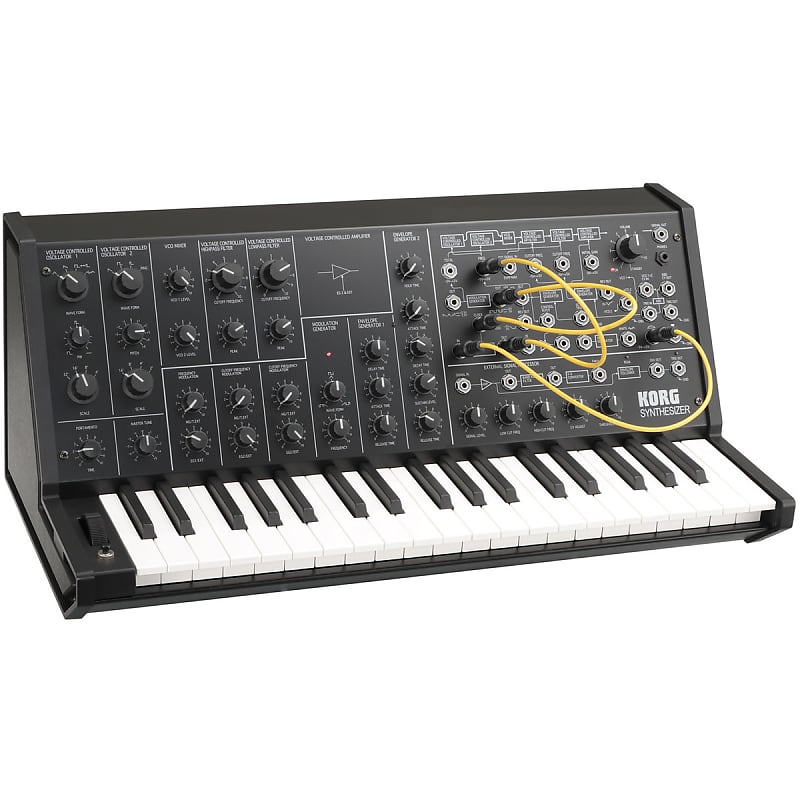

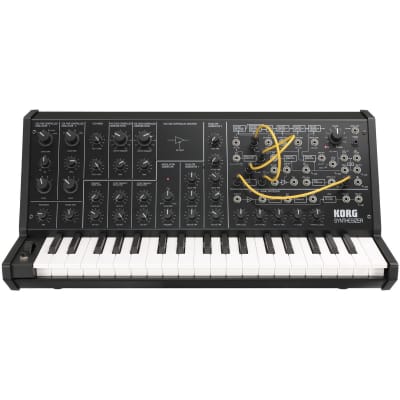
The MS-20 Mini has been painstakingly reproduced by the development team that produced the original MS-20, taking care to recreate the original circuitry for a faithful reproduction of the original sound. The rich and bright tones the MS-20 Mini produces is down to the internal circuitry, designed to produce the sound of the original MS-20 in mint condition before any of the components aged. The dual oscillators both feature ring modulation and envelope generators with hold and delay functions. The VCA is based on the original design but has been modified slightly to minimise the noise it produces for improved overall audio quality.
Self-Oscillating FiltersOne of the most revered features of the original MS-20 was its powerful filters, with the MS-20 Mini retaining these self-oscillating filters, providing resonance for both the high-pass and low-pass. The process works by maximising the resonance, in-turn causing the filter to self-oscillator and producing a noticeable change in tone. Fans of the MS-20 may know that the filter circuit was changed through its production cycle, with the MS-20 mini opting for the earlier filter, designed for a superior and more radical sound.
External Signal Processor (ESP)The External signal processor of the MS-20 Mini gives you the ability to use the pitch of volume of an external source to control your synth. The experimental nature of the ESP functionality, opens up a new world of flexibility, allowing you to input instruments such as electric guitars and use the MS-20 Mini and a guitar synthesizer, or attach a microphone to change it to a vocal synthesizer.
Flexible Patching SystemOne of the most prominent features of the MS-20 mini is its highly-flexible patching system. The patching system located to the right of the panel, gives you the ability to create complex new sound by changing cables between connections. Allow your imagination to run free with its countless combination between modulation, triggering, samples and noise generators, allowing you to produce a wide palette of tones and sounds. The accompanying flow chart allows novice users to easily take advantage of the patching system, giving you a crash course in synthesis straight out of the box.
Design & ConnectivityThe compact yet highly robust design of the MS-20 mini makes it perfect for studio and live performances alike. This mini version of the original MS-20 has been scaled down to 86 percent of its original size. The keybed features 37 notes in total, spanning three octaves for added versatility. In addition to its analog design, the MS-20 Mini also features USB & MIDI connectivity, ideal for using your MS-20 Mini with your favourite DAW, allowing you to incorporate the rich, warmth into your productions.
Features- Overseen by the engineers of the original MS-20 for a complete replication of the original analog circuity
- 2VCO / 2VCA / 2VCF / 2EG / 1LFO Structure
- Self-oscillating high-pass/low-pass filters with distinctive distortion
- External signal processor (ESP)
- Extremely flexible patching system
- Faithful recreation of the MS-20 at 86 of the size
- MIDI IN and USB connector
- Replicates every detail of the original, down to the package binding and the included manual
- Keyboard: C - C: 37-notes (3 octaves), mini keyboard designed specifically for the MS-20 mini
- Voltage Controlled Oscillator 1 (VCO 1):
- Scale (32', 16', 8', 4') (6 octaves, +cent, -cent)
- Wave form (Triangle, Sawtooth, PW-Square, White Noise) (4 modes)
- Pulse width adjust 1:1 - 1:infinity
- Voltage Controlled Oscillator 2 (VCO 2):
- Scale (16', 8', 4', 2') (6 octaves, +cent, -cent)
- Wave form (Sawtooth, Square, Pulse, Ring modulator) (4 modes)
- Pitch (± 1 octave)
- VCO Master control:
- Master tune (± 100cent)
- Portamento (max. 10sec)
- FFrequency modulation intensity by MG/T.EXT (-5V - +5V)
- Frequency modulation intensity by EG1/EXT (-5V - 0V)
- VCO Mixer:
- VCO 1 Level
- VCO 2 Level
- Voltage Controlled High Pass Filter (VCF HPF):
- Cutoff frequency (50Hz - 15,000Hz)
- Peak (flat - self OSC)
- Cutoff frequency modulation intensity by MG/T.EXT (-5V - +5V)
- Cutoff frequency modulation intensity by EG2/EXT (-5V - +5V)
- 7Voltage Controlled Low Pass Filter (VCF LPF):
- Cutoff frequency (50Hz - 15,000Hz)
- Peak (flat - self OSC)
- Cutoff frequency modulation intensity by MG/T.EXT (-5V - +5V)
- Cutoff frequency modulation intensity by EG2/EXT (-5V - +5V)
- Envelope Generator 1:
- Delay time (10sec)
- Attack time (10sec)
- Release time (10sec)
- Envelope Generator 2:
- Hold time (20sec)
- Attack time (10sec)
- Decay time (10sec)
- Sustain level (0V - 5V)
- Release time (10sec)
- 10. Modulation Generator (LFO):
- Wave form (Positive Sawtooth - Triangle - Negative Sawtooth, Wide Pulse - Square - Narrow Pulse)
- Frequency (0.1Hz 20Hz)
- 11. Manual controller:
- Cntrol wheel (center click)
- Momentary switch -->GND
- 12. Power switch and Volume:
- Volume
- 13. Indicator: LED (KBD trigger, Modulation Generator rate, Power ON)
- 1. Control section:
- Input signal level
- Low cut frequency (50Hz - 2,500Hz)
- High cut frequency (100Hz - 5,000Hz)
- CV adjust
- Threshold level
- 2. Input and Output:
- Signal In
- Amplifier Out
- Band pass filter Out
- CV Out (0 - +8.4V)
- ENV Out (0 - +5V)
- Trig Out (+5V-->GND)
- 3. Indicator (LED):
- Peak indicator
- Trigger indicator
- Keyboard:
- Keyboard control voltage output (Exponential) (0 - +8V)
- Keyboard trigger output (+5V-->GND)
- VCO-1 + VCO-2 control voltage input (Linear response) (0 - +8V)
- VCO-2 control voltage input (Linear response) (0 - +8V)
- VCO:
- VCO-1 + VCO-2 external frequency control input (OCT/V) (-5V - +5V)
- VCF:
- External signal input (3Vp-p max.)
- External High pass filter cutoff frequency control input (2OCT/V) (-5V - +5V)
- External Low pass filter cutoff frequency control input (2OCT/V) (-5V - +5V)
- VCO + VCF:
- Total external modulation input (T.EXT) (-5V - +5V)
- VCA:
- External initial gain control input (0 - +5V)
- EG: Modulation VCA:
- Control voltage input (0 - +5V)
- Signal input (-5V - +5V)
- Signal output (-5V - +5V)
- Manual controller:
- Control wheel output (-5V+5V)
- Momentary switch output (-->GND)
- Signal out:
- Signal output (mono 1/8" mini phone jack, 2Vp-p output impedance 3.5k Ω)
- Head phones:
- Head phones output (Stereo 1/8" mini phone jack, 33 Ω 48mW)
- USB:
- Type B, USB-MIDI Input/Output *Only note messages (velocity is not used) can be transmitted and received.
- MIDI:
- MIDI Input *Only note messages (velocity is not used) can be transmitted and received.
- Power Consumption: 9W
- Power Supply: DC9V
- Dimensions (W x D x H): 493 ×257 × 208 mm / 19.41 x 10.12 x 8.19 inches
- Weight: 4.8 kg / 10.58 lbs.
- Accessories: AC adaptor (9V/1.7A), Patch Cord x 10
| Condition | Brand New (New) Brand New items are sold by an authorized dealer or original builder and include all original packaging.Learn more |
| Brand | |
| Model |
|
| Finish |
|
| Categories | |
| Year |
|
